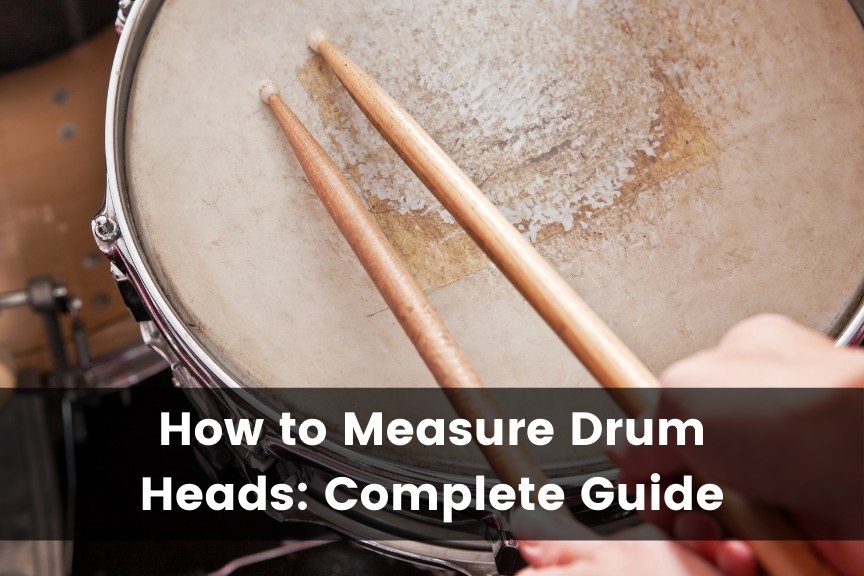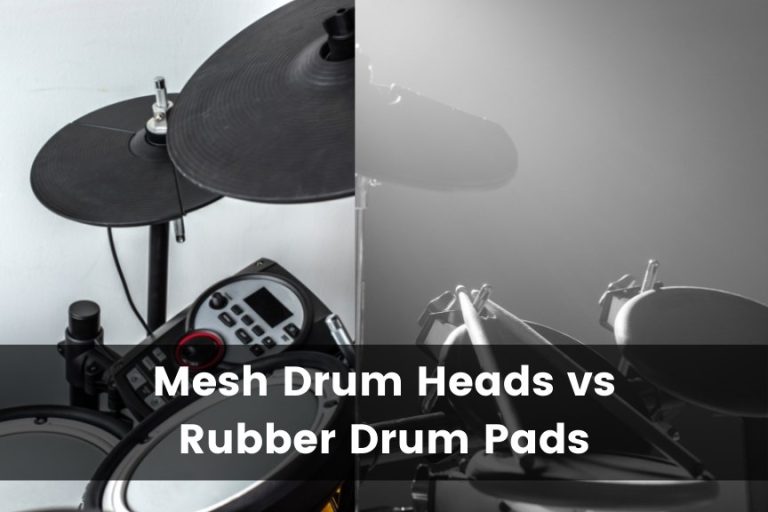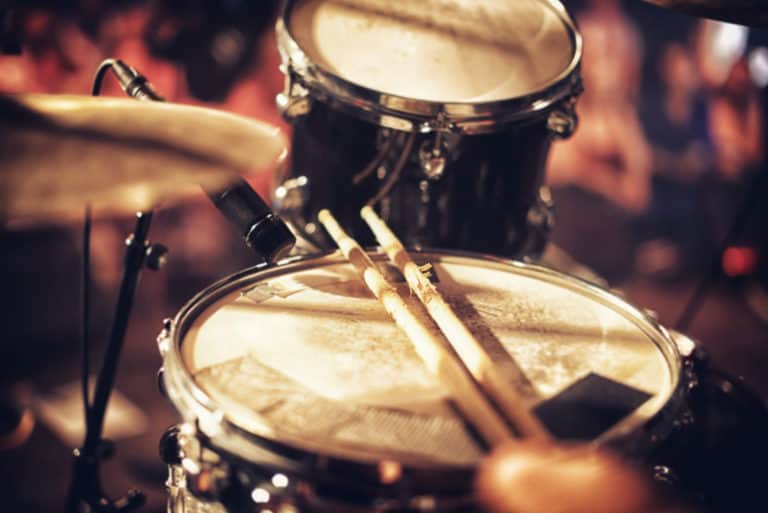How To Measure Drum Heads: Everything You Need to Know
It can be daunting walking into your local music shop for the first time to buy drum heads. Perhaps, like me, you incorrectly assumed that all drum kits looked like yours, and now you find yourself staring at a shelf of seemingly endless options. Don’t worry; we are here to help you figure out what sizes your drums are.
There are a few ways efficiently measure drum heads. First, you can use a tape measure to measure the widest point across the head of the drum. Another option is to use a string to determine the circumference of the drum and then calculate the diameter.
I can vividly recall how overwhelming some of the technicalities were when I started playing drums and trying to navigate my way around gear.
In this guide, you’ll learn exactly how to measure drum heads so you can confidently know your drum heads’ sizes area, as well as a few bonus tips you will find helpful.
The Quickest Way To Measure Drum Heads
The most common and quickest way to measure a drum head will only take you a few minutes using a tape measure and maybe a dry erase marker. However, it is also pretty easy to get it wrong, so follow the steps closely.
Step 1: Grab A Tape Measure
You will need a tape measure for this method. Alternatively, you can use a length of rope, but you will still need to measure it afterward. A fabric measure tape will also work just fine.
Step 2: Find The Longest Line Across The Head
You will be measuring the drum head across the widest point or longest line, so first, you must establish that line. To do this, you will be using the tensioning rods that hold the hoop in place, known as lugs.
Count the lugs to check if they are an even or odd number. If they are an even number, the two lugs on opposite ends are straight across from one another, marking the widest point across the head.
If the lugs are an uneven number, it generally means that they are not directly across. In this case, a lug on one side will be aligned with the center point between two lugs on the opposite side.
Grab a dry-erase marker and your tape measure. Find the center point between two lugs on the same side and lightly mark it. That point should now be across from the lug on the opposite side of the head. Boom.
Step 3: Measure Your Drum Head
Finally, you can use a tape measure or string to measure across the center line you have now established.
Just please, I beg you, do not measure the hoop as well. Heads are measured to fit the size of the drum, and the hoop is quite a bit wider than the drum. So, you need to measure to the inside of the hoop, not the outside.
For all you metric enthusiasts out there, I’m sorry to say, but drum heads are measured in inches, and no music shop is going to know what to give you if you go in asking for a 558-millimeter drum head.
Now record your measurement (in inches) and file it in your brain.
The Mathematical Way To Measure Drum Heads
If you are a math enthusiast or are not entirely sure that the quick and dirty method above is entirely accurate, you can use good old-grade-school functions to help you out. For this method, you need a string, measuring tape, and a calculator (if your basic math is as bad as mine).
Keep in mind that using this method to measure your kick drum will probably be more cumbersome than it’s worth.
Step 1: Measure The Circumference Of The Drum
First, you want to establish the circumference around the drum’s body by stretching the string all the way around the outer body of the drum. Then, pinch or mark the point where the string overlaps.
Now you can take that length of string and measure it from the tip to the mark to get the circumference of the drum.
Step 2: Calculate The Diameter
This is where things get a little tricky for us drummers who prefer to count in fours. Using the circle math formula C = πd, we can determine the diameter.
In this formula, “C” is the circumference we have just measured. The symbol “π” is pie, or 3.142 and “d” is the diameter we are trying to determine.
Assuming we measured a circumference of 38 inches, our formula will be:
38 = 3.142 x d
Now we can solve for diameter by changing the formula:
d = 38 ÷ 3.142
d = 12
So, by measuring the circumference and using the formula, we have determined that the diameter of this particular drum is 12 inches. And, seeing as how the drum head size equals the diameter, we now have the information we are looking for.
If you do not end up with a whole number using either this method or the method above, you are doing something wrong. This is because drum heads are ALWAYS in whole numbers and do not contain any fractions or decimals.
The Surest Way To Measure Drum Heads
There is one way to determine the size of your drum head that is pretty much without error. It’s a surefire way to get the correct size, but, unfortunately, it requires a bit more work than the previous methods.
All you need for this method is a drum key because you will be removing the drum head.
Step One: Loosen The Lugs
The first step here is to completely loosen all the lug nuts. This can be a tedious process, and there isn’t really a set pattern. Out of habit, I prefer to loosen them in a crisscross fashion, always going for the lug opposite the one I just removed.
If you have a cordless drill with the right type of female square bit, then you can get those lug screws out in no time. Just keep in mind that you can strip the screws if you do something silly.
Step Two: Count And Store The Lug Screws
Once you have all the screws removed, you may be tempted to whip off the head and get onto the next step, but please don’t.
Just stop for a minute, collect all the lug screws and heads, and count them. Make sure you have them all. Place them in some form of container like a zip-lock bag, Tupperware box, etc., and then store them safely.
You will be sorely angry with yourself if you come home with a brand new drum head, excited to test it out, only to spend two days playing “Where’s Wally” as you frantically search for a lug screw.
Step 3: Measure The Diameter Of The Drum Head
Please note that this step is optional, which is not what makes this method so reliable. Nevertheless, with the drum head removed, you don’t have the hoop in the way, making measuring the diameter easier.
Although, it may be harder to find an accurate centerline without the lugs. Instead, just measure it at the widest point and round off to the closest whole number, and then you should be in the right ballpark.
Step 4: Get A Definite Size
This will probably be either obvious or silly, but it really is the best option if you are absolutely new or unsure of what you are doing.
Take the drum head to your local music shop and ask them to determine the size. They will find the matching size out of the new box in no time, and you can then compare to make sure the sizes are exactly the same. Like I said, guaranteed.
Understanding Drum Sizes
One thing that can help you figure out if your measurements are correct is understanding that drum kits generally have standard sizes and configurations.
I mean to say that if you understand that most snare drums are 14 inches, and you measure yours at 14.5, you can be pretty confident that it’s a 14-inch snare, not 15.
There are two primary drum kit configurations for “off-the-shelf” drum kits. In other words, unless you have purchased a custom kit second-hand, you likely have one of the two.
These are fixed rules, especially for second-hand kits that have been customized, but they do give you a pretty good idea of standard sizes.
1. Rock / Standard Kit
The rock kit (AKA the standard kit size) is the most common drum kit configuration around, and if you have bought an entry-level drum kit, there is a significantly high chance that you have a rock kit.
The standard sizes for a rock kit are:
- A 14-inch snare drum
- A 12-inch tom
- A 13-inch tom
- A 16-inch floor tom, and
- A 22-inch kick drum.
Rock kits are great for a wide variety of play styles and settings. They also have the benefit of drum heads being widely available due to their popularity.
2. Jazz / Fusion Kit
The jazz/fusion kit is smaller than the rock kit. As a result, it’s less popular with beginner players who are still figuring out what they like and don’t like. Also, it doesn’t have the word “rock” in the name, which is what most beginner drummers want to do.
That being said, they are fantastic kits, versatile and better for softer, more sensitive play styles. Although, as an owner of a jazz kit, I can confirm that they are still rock-able.
The standard sizes for a jazz/fusion kit are:
- A 14-inch snare drum
- A 10-inch tom
- A 12-inch tom
- A 14-inch floor tom, and
- A 20-inch kick drum (some configurations have a full-sized 22-inch kick)
Knowing that your drum heads will likely fall within these parameters is gives you a good starting platform before you start measuring.
Finding Drum Head Sizes Online
Knowing the standard configuration sizes also means that you can consult the internet to discover your drum head sizes. Check on the side or inside of the drum shells for the manufacturer’s plate, which will indicate the make and model.
Armed with this information, you consult good old Google to find the drum head sizes. If that kit comes in two or more configurations, their website will likely tell you and list each configuration’s specs.
You then need to measure the size of the smallest tom to determine which configuration yours is and get the rest of the sizes online. This does come with some risk, so I would go out and spend hundreds of dollars on expense new drum heads on this information.
When Should You Buy New Drum Heads
Before shopping for new drum heads, establish if you actually need to change them. There are four clear indicators that you need to swap out those old heads.
The first and potentially most obvious sign is if the head is torn.
This tear might be evident and large enough to see through or drop your stick through, or it might be a sneaky and hidden tear. For example, if you’re struggling to maintain tension on your drum head, it could be that the head is torn.
The second sign is that the head is dimpled or has small dents. These dimples will also affect tension and tone, and it is best to change the head.
The third reason to change a drum head is if the coating on a coated head has worn away on the spot you hit the most. Again, this will affect the tone of the head.
The final reason to buy new drum heads is that you simply don’t like the ones you have or want to try a different type. Playing drums should be fun and personal, so feel free to experiment with various heads. Just make sure you buy the correct sizes.
Conclusion
There are many ways to measure and determine drum head sizes. The quickest is to measure the diameter at the widest part of the head using a measuring tape. Remember to measure inside the hoop. The second is to measure the circumference of the drum using a string and calculate the diameter.
The most reliable option, if you are not sure, is to remove your drum heads and go to your local music shop. The staff can assist you in determining the exact sizes. Also, keep in mind that understanding the standard drum kit configurations can help you figure out what sizes your heads are.







